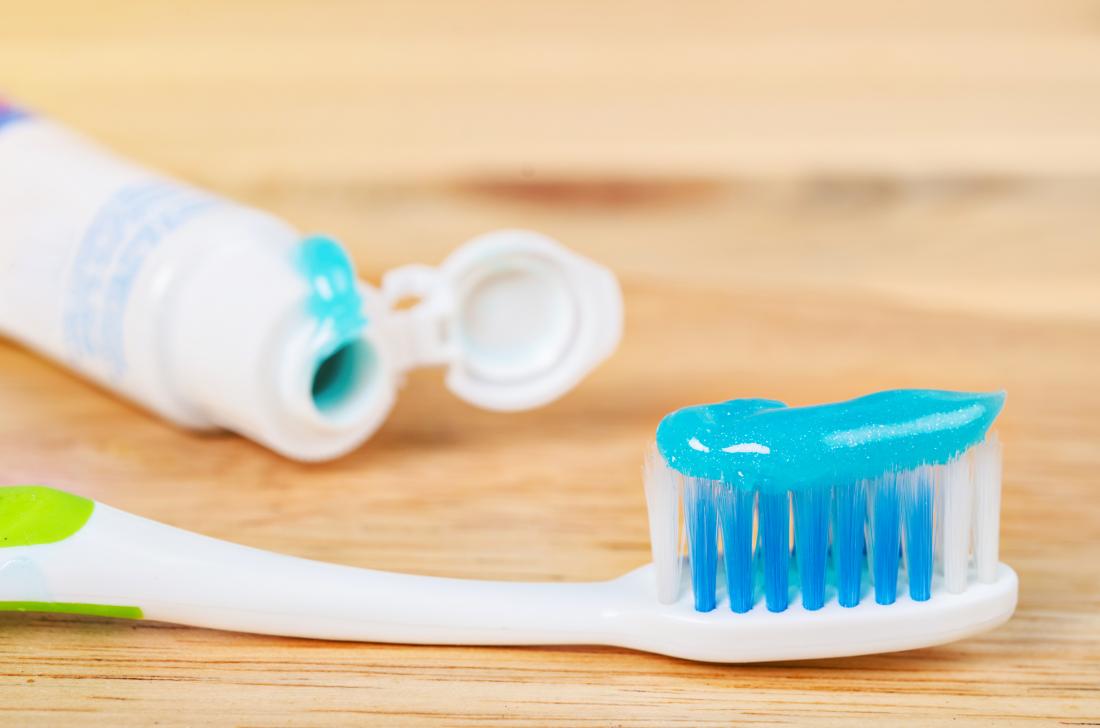Risks, uses, and side effects
Fluoride occurs naturally in soil, water, and food. It’s also made synthetically for use in drinking water, toothpaste, mouthwashes, and various chemical products.
Water authorities add fluoride to municipal water supplies as studies have shown that adding fluoride to areas with low fluoride levels in the water can reduce the prevalence of tooth decay in local populations.
Tooth decay is one of the most common health problems in children. Many people around the world cannot afford the cost of regular dental exams, so adding fluoride can offer savings and benefits to those who need it.
However, there have been concerns about the health effects of fluoride, including problems with bones, teeth, and neurological development.
Fast facts on fluoride
- Fluoride comes from fluroine, a common, natural, and abundant element.
- Adding fluoride to the water supply will reduce the incidence of tooth decay.
- Fluoride protects teeth from tooth decay through demineralization and remineralization.
- Too much fluoride can lead to dental fluorosis or skeletal fluorosis, which can damage bones and joints.
Excessive exposure to fluoride has been linked to a number of health problems.
Dental fluorosis
A fluoride level of 0.7 ppm is now considered to be the best for dental health. A concentration above 4.0 ppm can be dangerous.
Exposure to high levels of fluoride during childhood, when teeth are developing, can lead to mild dental fluorosis. There are tiny white streaks or spots in the enamel.
This won’t affect the health of your teeth, but the discoloration can be noticeable.
Breastfeeding infants or making formula with fluoride-free water can help protect young children from fluorosis.
Children under the age of 6 should not use mouthwash containing fluoride. Children should be supervised while brushing their teeth to ensure they do not swallow toothpaste.
Skeletal fluorosis
Excessive exposure to fluoride can lead to a bone disease known as skeletal fluorosis. This can cause pain and damage to bones and joints for many years.
The bones can become hard and less elastic, which increases the risk of fractures. When the bones thicken and bone tissue builds up, joint mobility can be impaired.
Thyroid problems
In some cases, excess fluoride can damage the parathyroid gland. This can lead to hyperparathyroidism, which involves uncontrolled secretion of parathyroid hormones.
This can lead to a calcium deficiency in the bone structures and to above-average calcium concentrations in the blood.
Lower levels of calcium in the bones make them more prone to fractures.
Neurological problems
In 2017, a report was published indicating that exposure to fluoride before birth could lead to poorer cognitive outcomes in the future.
The researchers measured fluoride levels in 299 women during pregnancy and in their children between the ages of 6 and 12 years. They tested cognitive skills between the ages of 4 and between 6 and 12 years of age. Higher fluoride levels were associated with lower values on IQ tests.
In 2014, fluoride, along with 10 other industrial chemicals including lead, arsenic, toluene, and methylmercury, was documented as a neurotoxin dangerous to child development.
Other health problems
According to the International Association of Oral Medicine and Toxicology (IAOMT), an organization campaigning against the use of added fluoride, it can also contribute to the following health problems:
- Acne and other skin problems
- Cardiovascular problems, including atherosclerosis and arterial calcification, high blood pressure, myocardial damage, heart failure, and heart failure
- reproductive problems such as lower fertility and early puberty in girls
- Thyroid dysfunction
- Joint and bone diseases such as osteoarthritis, bone cancer and TMJ disorder (TMJ)
- neurological problems that could potentially lead to ADHD
One review describes fluoride as an “extreme electron scavenger” with an “insatiable appetite for calcium”. The researchers call for a rethinking of the balance between risk and benefit.
Fluoride poisoning
Acute exposure to high levels of fluoride can result in:
- stomach pain
- excessive saliva
- Nausea and vomiting
- Seizures and muscle cramps
This does not result from drinking tap water. This is only likely if the drinking water is accidentally contaminated, for example due to an industrial fire or explosion.
It is worth remembering that many substances are harmful in large quantities, but helpful in small quantities.

Fluoride is added to many dental products.
Flouride is found in many water supplies and is added to drinking water in many countries.
It is also used in the following dental products:
- toothpaste
- Cements and fillings
- Gels and mouthwashes
- Lacquers
- some brands of floss
- Fluoride additives, recommended in areas where water is not fluoridated
Non-dental sources for fluoride include:
- Medicines containing perfluorinated compounds
- Food and drinks made from water containing fluoride
- Pesticides
- waterproof and dirt-repellent items with PFCs
Excessive fluoride exposure can be caused by:
- public water fluoridation
- high fluoride concentrations in natural fresh water
- fluoridated mouthwash or toothpaste
- untested mineral water
- inappropriate use of fluoride preparations
- some food
Not all fluoride exposure is due to adding the chemical to water and dental products.
In some geographic areas there is drinking water with naturally high fluoride content, e.g. B. in South Asia, the Eastern Mediterranean and Africa.
Possible side effects of excessive fluoride intake are:
- Discoloration of teeth
- Bone problems
Other possible side effects are listed in the “Risks” section above.

Flouride has been linked to reducing tooth decay.
The American Dental Association (ADA) says fluoride in water benefits communities because it:
- reduces tooth decay by 20 to 40 percent
- protects against cavities
- is safe and effective
- saves money on dental treatment
- is natural
Fluoride is found in natural water. Adding fluoride, says the ADA, is like fortifying milk with vitamin D, orange juice with calcium, or grains with B vitamins and folic acid.
Studies also show that adding fluoride to water is beneficial for dental health.
A Cochrane study published in 2015 found that when fluoride was introduced into water:
- Children had 35 percent fewer decayed, missing or filled milk teeth.
- There was a 15 percent increase in children with no tooth decay in their milk teeth.
- The proportion of children without tooth decay in their permanent teeth rose by 14 percent.
Applying fluoride to children’s teeth can prevent or slow tooth decay.
How does it work?
Fluoride prevents tooth decay by:
- Changes in the structure of the developing tooth enamel in children under 7 years of age so that it is more resistant to acid attacks
- Providing an environment in which better quality enamel is formed that is more resistant to acid attack
- Decrease in the ability of bacteria in plaque to produce acid
This includes the following processes:
Protection against demineralization: When bacteria combine with sugar in the mouth, they produce acid. This acid can erode tooth enamel and damage our teeth. Fluoride can protect teeth from demineralization caused by the acid.
Remineralization: When acid has already caused some damage to the teeth, fluoride builds up in the demineralized areas and begins to strengthen the tooth enamel. This is remineralization.
Who will benefit the most?
Anyone can benefit from extra mouthguard, but those who can especially benefit from it are people who:
- enjoy snacking
- have poor dental hygiene
- have little or no access to a dentist
- Follow diets that are high in sugar or carbohydrates
- had bridges, crowns, braces and other restorative procedures
- have a history of tooth decay or tooth decay
Most health authorities and medical associations around the world recommend that children and adults receive some fluoride to protect their teeth from tooth decay.

Small amounts of fluoride are unlikely to be dangerous.
Here are some facts that support the use of fluoride:
- From 2000 to 2004, 125 parishes in 36 US states voted to introduce fluoridation.
- In the right amounts, fluoride helps prevent tooth decay.
- It’s similar to adding vitamins to food.
- Using fluoride in water to protect teeth reduces the need for costly dental procedures.
- Over 100 national and international health and other organizations recognize the benefits of adding fluoride.
Here are some arguments against its use from the IAOMT:
- Fluoride is a neurotoxin that can be harmful in high doses.
- Excessive exposure can lead to tooth discoloration and bone problems.
- There is already enough fluoride in the water without adding more.
- People have the right to choose whether to take medication or not.
- Different people need different amounts of substances like fluoride.
- The current level of fluoride in the water may not be certain.
- It can be harmful to the environment.
The controversy continues over whether or not it is a good idea to add fluoride to water.
In 2000, German researchers reported that tooth decay decreased in cities where fluoride was no longer added to the water.
However, they called for further research into the reasons for this decline, which they believe could be due to improved attitudes towards dental health and easier access to dental health products compared to the years prior to the addition of fluoride.
They suggested that their results might support the argument that lowering the fluoride concentration from 1ppm to below 0.2ppm can further decrease tooth decay.
How Much Fluoride is Recommended?
The Department of Health and Human Services (DHHS) sets the optimal fluoride level for preventing tooth decay at 0.7 ppm or 0.7 milligrams (mg) per liter of water.
The previous figure, in effect from 1962 to 2015, was 0.7 to 1.2 ppm. In 2015 it was revised to the lower limit.
The aim of this optimal level is to promote public health.
What does the WHO say?
The World Health Organization (WHO) notes that long-term exposure to drinking water containing more than 1.5 ppm fluoride can lead to health problems. The WHO limit values are 1.5 ppm.
How much does the EPA allow?
The Environmental Protection Agency (EPA) aims to protect people from excessive exposure to toxic chemicals.
The maximum permissible value is 4 ppm and the secondary maximum is 2 ppm. People are asked to notify the EPA if the levels are above 2ppm. Values above 4 ppm can be dangerous.
In areas where water naturally contains higher levels of fluoride, municipal water systems must ensure that the maximum level does not exceed 4 ppm.
As with any substance, excessive ingestion or exposure can be harmful.
It’s important not to use fluoride supplements without talking to a dentist first.
Read the article in Spanish.



Comments are closed.